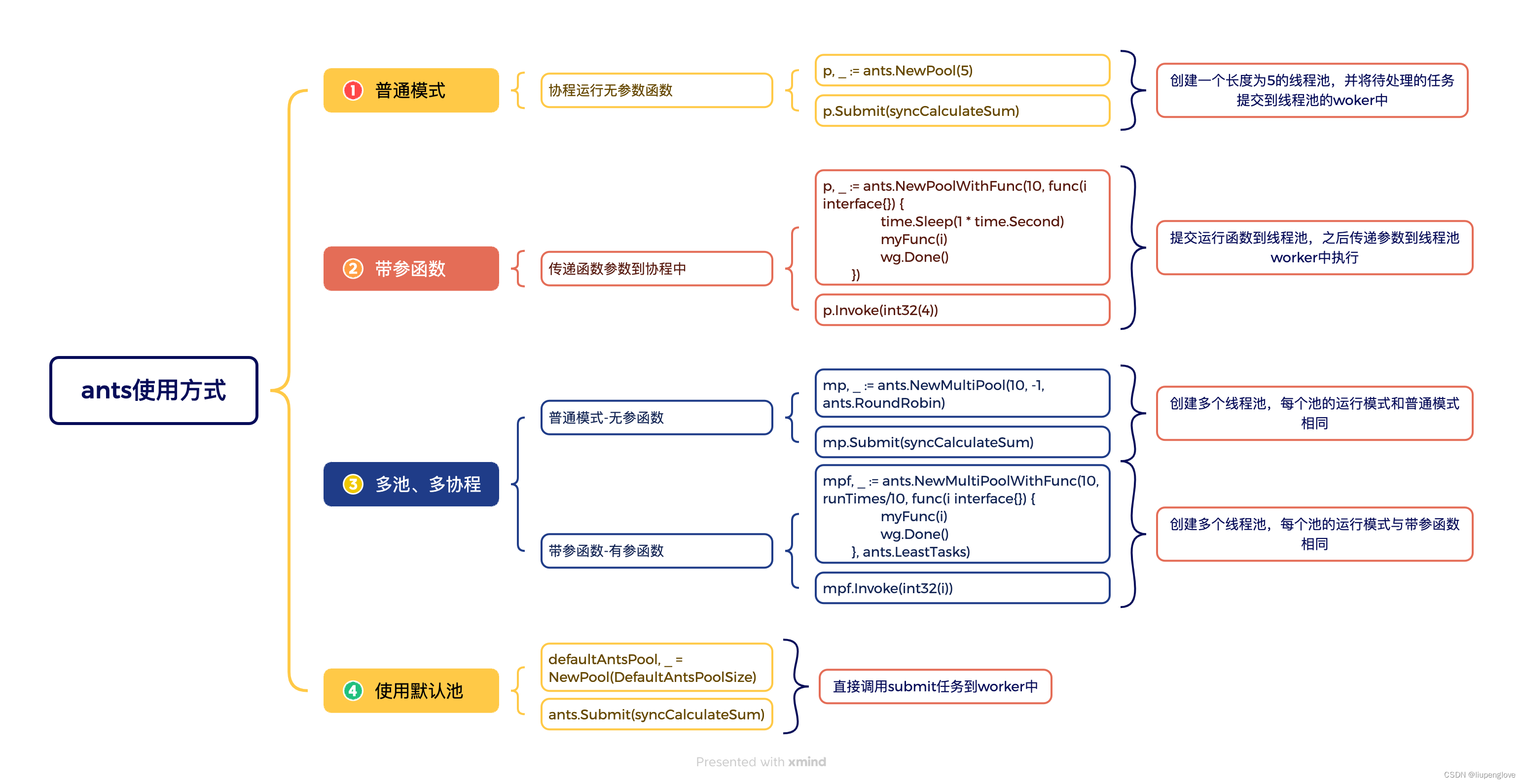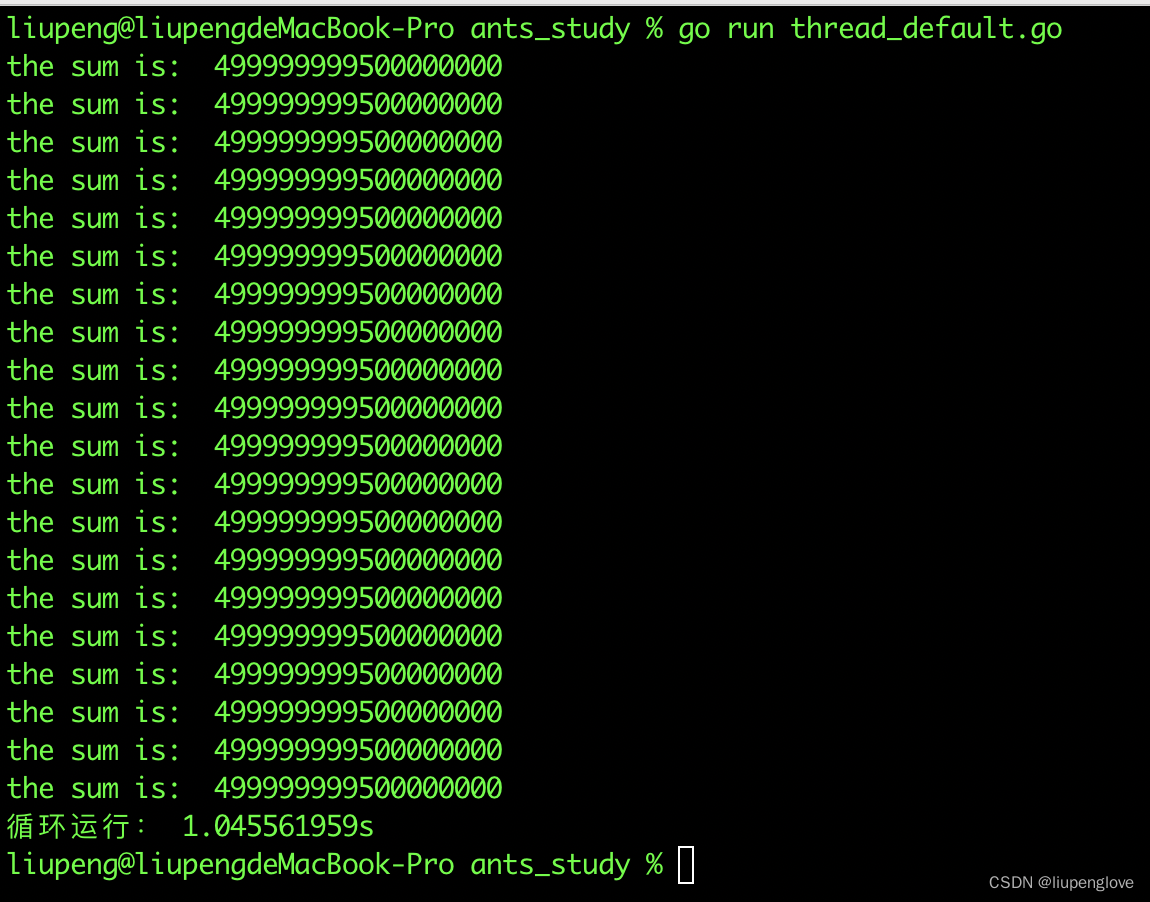目录
1、ants介绍
众所周知,goroutine相比于线程来说,更加轻量、资源占用更少、无线程上下文切换等优势,但是也不能无节制的创建使用,如果系统中开启的goroutine过多而没有及时回收,也会造成系统内存资源耗尽。
ants是一款高性能的协程管理池,实现了协程的创建、缓存、复用、刷新、停止等功能,同时允许开发者设置线程池中worker的数量、线程池本身的个数以及workder中的任务,从而实现更加高效的运行效果。
2、使用方式汇总
ants的使用有四种方式,分别如下:

这四种使用方式,前两种最常用,基本能满足日常系统的开发需要,第四种默认池,简单的场景也可以用,但不推荐,多池的情况还没想到特别合适的应用场景。
3、各种使用方式详解
3.1 默认池
ants在启动时,会默认初始化一个协程池,这部分代码位于ants.go文件中:
var (
// ErrLackPoolFunc will be returned when invokers don't provide function for pool.
ErrLackPoolFunc = errors.New("must provide function for pool")
// ErrInvalidPoolExpiry will be returned when setting a negative number as the periodic duration to purge goroutines.
ErrInvalidPoolExpiry = errors.New("invalid expiry for pool")
// ErrPoolClosed will be returned when submitting task to a closed pool.
ErrPoolClosed = errors.New("this pool has been closed")
// ErrPoolOverload will be returned when the pool is full and no workers available.
ErrPoolOverload = errors.New("too many goroutines blocked on submit or Nonblocking is set")
// ErrInvalidPreAllocSize will be returned when trying to set up a negative capacity under PreAlloc mode.
ErrInvalidPreAllocSize = errors.New("can not set up a negative capacity under PreAlloc mode")
// ErrTimeout will be returned after the operations timed out.
ErrTimeout = errors.New("operation timed out")
// ErrInvalidPoolIndex will be returned when trying to retrieve a pool with an invalid index.
ErrInvalidPoolIndex = errors.New("invalid pool index")
// ErrInvalidLoadBalancingStrategy will be returned when trying to create a MultiPool with an invalid load-balancing strategy.
ErrInvalidLoadBalancingStrategy = errors.New("invalid load-balancing strategy")
// workerChanCap determines whether the channel of a worker should be a buffered channel
// to get the best performance. Inspired by fasthttp at
// https://github.com/valyala/fasthttp/blob/master/workerpool.go#L139
workerChanCap = func() int {
// Use blocking channel if GOMAXPROCS=1.
// This switches context from sender to receiver immediately,
// which results in higher performance (under go1.5 at least).
if runtime.GOMAXPROCS(0) == 1 {
return 0
}
// Use non-blocking workerChan if GOMAXPROCS>1,
// since otherwise the sender might be dragged down if the receiver is CPU-bound.
return 1
}()
// log.Lmsgprefix is not available in go1.13, just make an identical value for it.
logLmsgprefix = 64
defaultLogger = Logger(log.New(os.Stderr, "[ants]: ", log.LstdFlags|logLmsgprefix|log.Lmicroseconds))
// Init an instance pool when importing ants.
defaultAntsPool, _ = NewPool(DefaultAntsPoolSize)
)使用起来就比较简单了,直接往池子里提交任务即可。
package main
import (
"fmt"
"sync"
"time"
"github.com/panjf2000/ants/v2"
)
func add(d int) {
sum := 0
for i := 0; i < d; i++ {
sum += i
}
}
func main() {
var wg sync.WaitGroup
now := time.Now()
for i := 0; i < 5; i++ {
wg.Add(1)
ants.Submit(func() {
add(10000000000)
wg.Done()
})
}
wg.Wait()
fmt.Println(time.Since(now))
now = time.Now()
for i := 0; i < 5; i++ {
add(10000000000)
}
fmt.Println(time.Since(now))
}
运行结果:

3.2 普通模式
普通模式和使用默认池非常类似,但是需要自己创建一个线程池:
p, _ := ants.NewPool(5)函数参数为协程池协程个数,测试代码如下:
package main
import (
"fmt"
"sync"
"time"
"github.com/panjf2000/ants/v2"
)
func add(d int) {
sum := 0
for i := 0; i < d; i++ {
sum += i
}
}
func main() {
var wg sync.WaitGroup
now := time.Now()
p, _ := ants.NewPool(5)
for i := 0; i < 5; i++ {
wg.Add(1)
p.Submit(func() {
add(10000000000)
wg.Done()
})
}
wg.Wait()
fmt.Println("协程池运行:", time.Since(now))
now = time.Now()
for i := 0; i < 5; i++ {
add(10000000000)
}
fmt.Println("循环运行:", time.Since(now))
}
3.3 带参函数
带参函数,重点是往worker中传递函数执行的参数,每个workder中都是同一个执行函数。
package main
import (
"fmt"
"sync"
"time"
"github.com/panjf2000/ants/v2"
)
func add(d int) {
sum := 0
for i := 0; i < d; i++ {
sum += i
}
fmt.Println("the sum is: ", sum)
}
func main() {
var wg sync.WaitGroup
now := time.Now()
p, _ := ants.NewPoolWithFunc(5, func(i interface{}) {
add(i.(int))
wg.Done()
})
for i := 0; i < 5; i++ {
wg.Add(1)
p.Invoke(1000000000)
}
wg.Wait()
fmt.Println("循环运行:", time.Since(now))
}
运行结果:
liupeng@liupengdeMacBook-Pro ants_study % go run thread_default.go
the sum is: 499999999500000000
the sum is: 499999999500000000
the sum is: 499999999500000000
the sum is: 499999999500000000
the sum is: 499999999500000000
循环运行: 352.447333ms3.4 多池多协程
这种模式,就是声明了多个协程池,每个池子里有多个协程在跑。
package main
import (
"fmt"
"sync"
"time"
"github.com/panjf2000/ants/v2"
)
func add(d int) {
sum := 0
for i := 0; i < d; i++ {
sum += i
}
fmt.Println("the sum is: ", sum)
}
func main() {
var wg sync.WaitGroup
runTimes := 20
now := time.Now()
mpf, _ := ants.NewMultiPoolWithFunc(10, runTimes/10, func(i interface{}) {
add(i.(int))
wg.Done()
}, ants.LeastTasks)
for i := 0; i < runTimes; i++ {
wg.Add(1)
mpf.Invoke(1000000000)
}
wg.Wait()
fmt.Println("循环运行:", time.Since(now))
}
运行记录:

4、总结
以上就是ants协程池所有的使用方式,3.2、3.3章节介绍的两种方式比较常用,也是推荐的使用方式,使用协程池,可以有效的控制系统硬件资源的使用,防止机器被打满,对于高并发服务非常推荐使用。
后面会学习一下ants的源码,并整理成文档发出来,欢迎围观。






















 6503
6503











 被折叠的 条评论
为什么被折叠?
被折叠的 条评论
为什么被折叠?








